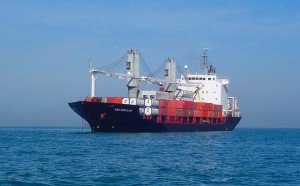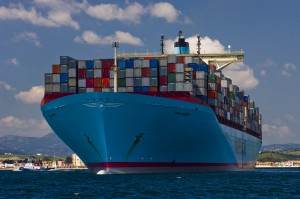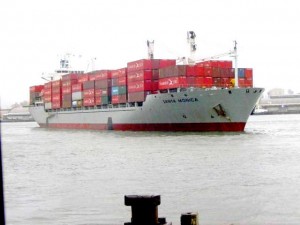Companies show intent to expand the use of cabotage
 Moving less than 10 % of the national burden , transportation by ship along the coast of the country ( cabotage) demand has to grow . According to the study Ilos – Institute of Logistics and Supply Chain – 68 % of users intend to increase freight transport volume moved by coastal shipping in the next two years. Were heard 100 companies of various sizes and industries . Among respondents who predict expansion , the intention is to increase cargo volume by 36% , on average.
Moving less than 10 % of the national burden , transportation by ship along the coast of the country ( cabotage) demand has to grow . According to the study Ilos – Institute of Logistics and Supply Chain – 68 % of users intend to increase freight transport volume moved by coastal shipping in the next two years. Were heard 100 companies of various sizes and industries . Among respondents who predict expansion , the intention is to increase cargo volume by 36% , on average.
According to the survey , the route with the greatest potential for expansion in Brazil ‘s Manaus – Santos – Manaus . The capital of Amazonas state , headquarters of the Free Zone , is not accessible by road from the Southeast . In 2011, we handled 193 million tons by cabotage , after an average increase of 4 % per year since 2004 . However, to continue to grow , you must expand the infrastructure , both with more ports as terminals and associated rail and road access , the vision of the director ‘s business Ilos , João Guilherme Araujo
Among the obstacles , delays in traffic loads and lack of infrastructure are identified by entrepreneurs as the main problems of cabotage . Araujo also draws attention to the issue of bureaucracy , that 52 % of respondents cited as a difficulty . The director of Ilos comments that there is no efficient regulation multimodal ( in different ways ) and that the cabotage receive equivalent treatment to foreign trade , with detailed descriptions of products on invoices and tax discrimination . The same does not occur in long-distance trucking.
The executive vice president of the National Union of Maritime Navigation ( Syndarma ) , Roberto Galli , sum up to realize that the development of cabotage in recent years . “This growth should be boosted by the expected increase in the number of vessels engaged in this mode of transport ,” predicts director . As Galli , recent logistics alternatives offered to the market by shipowners have led the charge transfer to traditional road cabotage.
In order to meet this potential demand suppressed , the owners have invested in the renewal and increase of capacity of its merchant fleets . The program Empresa Brasileira de Navigation ( EBN ) allow the construction by the private sector , 39 ships over the next ten years. Another important initiative aimed at building executive vice president of Sydarma , the Program for Modernization and Expansion of the Transpetro Fleet ( Promef ) allow also the same period , the inclusion of 49 new vessels in the fleet this state.
Galli notes that almost all of the new units in cabotage is associated with the transportation of oil and its derivatives . ” Thus we see the need to create mechanisms charter loads that do not relate to oil, in order to induce greater participation of cabotage in their logistics ,” maintains . In Brazil , the official reports that loads more cabotage use at the moment are items such as mineral oils , fuels , wood, pulp , among others.
The executive vice president of the Brazilian Association of Shipowners Cabotage ( Abac ) , André Mello , agrees that there is much room to evolve . For him , the segments in which the loads are above 1500 km and 200 km away from the coast have the potential to migrate to the coastal container . ” And the rise of class C should contribute to this, as it extends the general consumer ,” anticipates leader . Mello says that in the next five years , it is expected that the sector will grow at least 10 % . The leader shows how the main advantages of this area compared to other logistics options : the lowest cost on shipping , safer delivery ( theft rates near zero load ) and less damage to the product.
However , the representative of Abac stresses that there are many factors to be improved so that the cabotage container may have increased even more . One is bureaucracy . ” As in other modes , such as road , contracts are executed in a simple and agile in cabotage are bureaucratic requirements – similar to the import of products – which burdens and delays the service ,” laments the leader . Furthermore , the lack of infrastructure and overhead Brazilian ports are major barriers to the development of the sector . ” It is also necessary to review the policy for fuels , which today is clearly subsidized in the country , benefiting the road , in order to adapt it to cabotage ,” he concludes.
Port of Rio Grande esteem increased drive down the coast to 12%
Last year, the Port of Rio Grande reached its operational record with the movement of approximately 30.4 million tons of cargo . Given the type of shipping , cabotage was responsible for 2.1 million tonnes of this total . The superintendent of the Port of Rio Grande , Dirceu Lopes , reveals that the perspective is that cabotage have a greater representation by the end of 2012.
The manager estimates that this will achieve a modal share of about 12 % of the cargo handled by the Port of Rio Grande this year . The total movement of the complex should reach somewhere around 28 million tonnes less than in 2011 due to the impacts caused by drought , which reduced the grain harvest.
Among the major loads displaced by coastal and passing through the state today are rice, wheat , salt , liquid bulk , among others . Popular destinations , leaving Rio Grande , are the northeastern states . For Lopez, this is a good time to discuss the issue of cabotage , since the country may have to face the risk of a blackout logistics , if he maintains significant growth as its economy.
He also highlights that it is not a replacement for modal , but a complementarity . “The burden is not on the harbor side , she will have to go there by truck,” emphasizes the superintendent . He cites as an advantage of cabotage transport the possibility of obtaining a larger scale volumes. Lopes criticizes the fact that Brazil does not use the full potential that this sector has .
He points out that Brazil has a length of over 7400 km of coastline and most of the production centers is less than 500 km of coastline . ” The nation points to a maritime vocation ,” says the director . Lopes argues for a revolution of the concept of cabotage in Brazil . He argues that it is necessary to implement a policy of government to think of the logistics in an integrated way . The superintendent reminds many charges currently out of Rio Grande do Sul and go to the north and northeast by road ( it calculates that covers around 3000 trucks per month) and that the goods could be moved by coastal shipping . ” This scenario happens for various reasons, until the focus given to railroads and no investment in coastal shipping ,” he explains.
Lower environmental impact is considered one of the advantages
In a time when the environmental issue is so highly prized , cabotage is seen as a means of transport less aggressive . The national manager cabotage Alliance Navigation and Logistics , Jaime Batista , who was in Porto Alegre attending seminar on modal , reports that a cargo of 1000 tons of rice, busy Pelotas ( RS ) and Fortaleza ( CE ) by modal road will involve the issuance of 225 tons of CO2 . If adopted cabotage, this volume falls to 70 tons.
Batista cites as challenges to be overcome for the development of coastal issues in the country as the cost of fuel , which affect how Cide taxes and VAT , and a greater demand than supply of labor for the crew . Moreover , he cites the bureaucracy with the activity , which is subject to Siscomex Load ( IRS system control the movement of vessels , cargo and empty containers transported by waterway in Brazilian ports ) and determinations of the National Agency for Sanitary Vigilance ( ANVISA ).
“The tripod reliability , competitiveness and sustainability is what companies want and is what cabotage has to offer,” says Batista . The Alliance Shipping and Logistics (controlled by the Hamburg Süd Group and headquartered in São Paulo ) was a pioneer in the regular service of containerized cargo along the Brazilian coast , starting the service in 1998 . After three more owners now operate regularly : Log In, Mercosul Line and Maestra . These companies operate 19 ships that meet weekly to the main ports of Manaus to Rio Grande. Are under construction or in the process of hiring another nine vessels with an average capacity of 2500 TEUs ( equivalent units 20ft container ) for each operation solely on the Brazilian coast . The total number of containers handled at the national cabotage is currently approximately 600,000 TEUs per year.
Vessel characteristics hinder combination with inland
The fact of the Rio Grande do Sul having one of the best knitwear waterways in the country generates questions about the use of non- modal cargo to ship in the ports of the Star and the state capital to more distant destinations such as North and Northeast Brazil . The major drawback for this to take place are the differences between the ships used in the two practices
The Chairman of the Board of Directors of Trevisa (parent company Gaucho Navigation Alliance ) , Fernando Ferreira Becker clarifies that vessels built specifically for inland navigation are unable to operate at sea. Vessels operating in the ocean need a higher power to overcome obstacles such as high waves. Furthermore, the caps of the holds must be strengthened.
He informs that the company focuses on the waterway , and one reason is precisely the high costs involved in cabotage . The company usually takes the load to the waterway Rio Grande and there she is placed in larger vessels to make the long haul . The leader said , regarding navigation is interior, coastal or long haul , ” nothing is satisfactory in Brazil .” For him , the law outdated and lack of vision regarding the benefits with the use of navigation make this scenario.
Alliance invests in new technologies to improve processes
 Technology is a tool used by Alliance Shipping and Logistics to develop cabotage . To facilitate communication and further streamline operational processes , the company began using in 2011 , EDI ( Electronic Data Interchange ) in order to increase efficiency in the exchange of information between the company and customers cabotage.
Technology is a tool used by Alliance Shipping and Logistics to develop cabotage . To facilitate communication and further streamline operational processes , the company began using in 2011 , EDI ( Electronic Data Interchange ) in order to increase efficiency in the exchange of information between the company and customers cabotage.
Since then , the Alliance has developed EDI interfaces that increase the effectiveness of transportation with multiple clients and currently provides the program data to the Invoice ( Notfis ) , Electronic Data Invoice ( NF -e) , Embedded Knowledge ( Conemb ) , Document Collection ( Doccob ) Occurrence in Delivery of Goods ( Ocoren ) and Position of Travel ( Posvia ).
According to the manager ‘s coastal Alliance , Gustavo Costa , key customers segments of electronics and steel are the major partners in EDI cabotage . ” We also have EDI systems with our partners in the operational interfaces , making it possible to identify possible non -conformities as delays in loading the cargo delivery, the customer arrival time of spawning container . So we have to take corrective actions in advance , and meet customers’ specific requests with regard to information”, he explains.
According to the executive , the EDI is only a single manual entry of information at source, thus avoiding errors in the remaining stages of the process , since the absorption data is done automatically in both the Alliance as the clients. ” Furthermore , with the use of EDI , electronic commerce and encourage the use of new technologies , standardizing the relationship between business, planning the logistics of delivering the early receipt of the information”, says Costa.
Source: Jornal do Commercio/RS / Jefferson Klein








